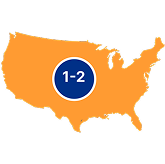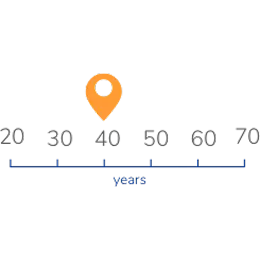GAMMAGARD LIQUID is indicated as a maintenance therapy to improve muscle strength and disability in adult patients with Multifocal Motor Neuropathy (MMN). GAMMAGARD LIQUID for MMN is for intravenous use only.
What is MMN?
MMN=Multifocal Motor Neuropathy.

What is MMN?
MMN is a rare immune-mediated motor neuropathy, which presents as slowly progressive, asymmetric, and predominantly distal limb weakness.1,2
Weakness typically begins in the fingers or thumb and may include involuntary fasciculations and cramping. As the disease advances, patients may experience wrist drop, foot drop, and/or loss of grip strength, weakness, and may move proximally.2-4

MMN has a prevalence of 1-2 in 100,0002

MMN affects nearly 3x more men than women1

Mean age onset of 40 years (range 20-70 years)1
Diagnosis is often delayed
MMN presents with symptoms similar to those of other neuropathies, such as amyotrophic lateral sclerosis (ALS). As a result, misdiagnosis does occur and contributes to delays in diagnosis.1
Unfortunately, for many patients it can take a considerable amount of time from symptom onset to receiving a diagnosis. The mean time to diagnosis is 6 years (range: <1-23 years).4* If left undiagnosed and unmanaged, MMN continues to progress.1,3
Undiagnosed and unmanaged, MMN continues to progress1,3
*Mean time it takes to get MMN diagnosed based on retrospective case cohort study of 47 patients with MMN followed for up to 12 years.
AMEND the time to diagnosis
When considering MMN, AMEND—an acronym created by TAKEDA—can help you recognize some of the hallmark symptoms.†
Asymmetric
Distribution of weakness is asymmetric2-4
Motor without sensory
Motor impairment (muscle weakness) without objective sensory impairment3
Elevated anti-GM1 antibody titers
Present in around 50% of patients5
Nerve conduction block
Typically present, but may be activity dependent and difficult to detect. May be easier to detect in advanced disease1,2,6
Distal
Most common clinical presentation of weakness typically affects the distal arm/leg muscles2-4
†In addition to the above, muscle mass is preserved despite profound weakness in early disease but may be decreased due to atrophy in advanced disease. Axonal damage and loss are correlated with muscle weakness and may be less pronounced in early stages.
It is important to diagnose MMN as early as possible
Though MMN cannot be cured, many patients respond to treatment. Disease progression depends on how long patients remain undiagnosed.1,2
Want to learn more?
Stay up-to-date on GAMMAGARD LIQUID.
References:
- Vlam L, van der Pol WL, Cats EA, et al. Multifocal motor neuropathy: diagnosis, pathogenesis and treatment strategies. Nat Rev Neurol. 2012;8(1):45-58.
- Katirji B, Koontz D. Disorders of peripheral nerves. In: Daroff RB, Fenichel GM, Jankovic J, Mazziotta JC, eds. Bradley’s Neurology in Clinical Practice. Vol 2. 6th ed. Saunders Elsevier; 2012:1915-2015.
- Shy ME. Peripheral neuropathies. In: Goldman L, Schafer AI, eds. Goldman’s Cecil Medicine. 25th ed. Saunders Elsevier; 2016:2527-2537.
- Slee M, Selvan A, Donaghy M. Multifocal motor neuropathy: the diagnostic spectrum and response to treatment. Neurology. 2007;69(17):1680-1687.
- Lawson VH and Arnold WD. Multifocal motor neuropathy: a review of pathogenesis, diagnosis, and treatment. Neuropsychiatr Dis Treat. 2014;10:567-576.
- Van Schaik IN, Van den Berg LH, De Haan R, Vermeulen M. Multifocal motor neuropathy. In: Gilhus NE, Barnes MP, Brainin M, eds. European Handbook of Neurological Management: Volume 1. 2nd ed. Blackwell Publishing Ltd; 2011:343-350.